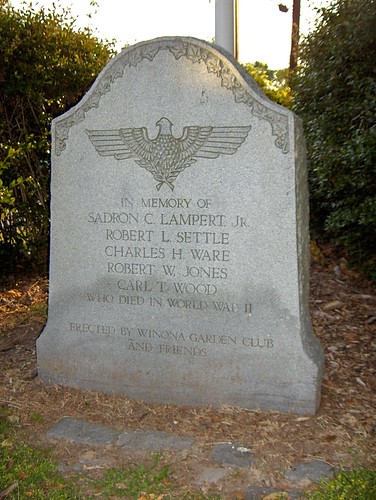Being that this is an older neighborhood, and the eagle is hard to miss, I realized that this had to be a monument of some kind.
We have all been to the
What could be more personal than a neighborhood monument that simply states, "These were our neighbors that fought and died for us."

(you can see the high res here )
How common are these little neighborhood monuments? I did a quick search for these names on the Internet. Inside a day I found out that in 1935,
I found out more about Sadron C. Lampert Jr. through has close relatives in the area that I managed to find. In a quick email exchange I found out some detail that, when you think about it, every name on every monument has. When you look at these men, struck down in the prime of life, you have to think about the lost potential. For you economists out there, the opportunity costs for a society of those lost in conflict is huge. Earn it we should. With his permission, the grandson of Sadron C. Lampert sent a quick background.
While I obviously never had the honor of meeting him, his father (Sadron Sr.) was alive until I was about nine. Sadron Jr. was killed when my father was just one or two.By going to the outstanding
He skipped two grades in high school and went to Yale, where he played football and graduated PhiBetaKappa. He went to work for a firm in New York, where he met my grandmother (boss's daughter, if I'm not mistaken).
Sadron Jr. was drafted into the Army in late 1943. He served as a communications officer in Europe. He, like all the Sadrons, had pretty poor eyesight and was constantly breaking his glasses. This may have contributed to the circumstances of his passing. He died in September, 1944 near Empoli, Italy. He was posthumously awarded a Purple Heart.
The irony is, the Winona Garden Club no longer exists, but as you can tell, someone in the neighborhood is keeping the monument up. Somewhere, on microfiche I'm sure, is the story. The questions are still there though; did they know each other before they left overseas? Did their families know each other? Did the families stay after their death? Did they serve together?
I've been to the WWII monument in D.C. and this little neighborhood monument had much more of an affect on me. Perhaps it is the personal nature of it, or the depth that Sadron Lampert, Jr.'s grandson provided. Next time I see something like this hidden in a corner, I'm going to walk over and see. Afterall, that is what they were put there for. The former members of the Winona Garden Club succeded. Decades later, people are still giving tribute to their neighbors.









No comments:
Post a Comment